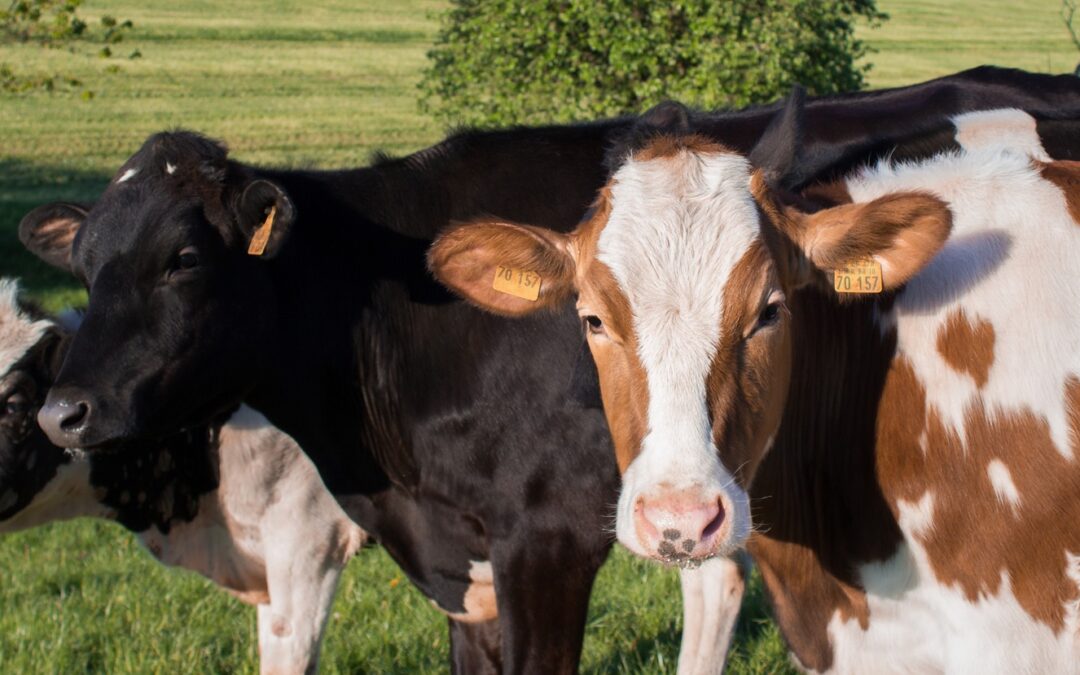Ireland is one of the World leaders when it comes to dairy production. Ireland is well-known for its excellent land quality and our wet humid weather conditions. In Ireland we have over 18,500 dairy farmers and produce 5,400 billion litres of milk annually. The main dairy breed in Ireland is Holstein Friesian although this trend is changing thanks to genetics. Irish dairy farmers are now using cross breeds with the help of genetics. EBI (Economic Breeding Index) an index genetics companies use to show farmers what qualities this breed has. Dairy farmers tend to pick breeds that have high milk solids e.g. high protein, high butterfat, etc. Dual purpose breeds (beef and dairy) such as Fleckvieh and Montbéliarde have became popular in recent times so dairy farmers can get better quality calves.
Irish dairy cows can produce peak milk yields of 6 gallons (27L) per milking. This usually occurs in the month of April and May when grass quality is at its highest. Cows who give birth in the Spring produce the highest yields in the summer. Good quality grass plays a huge role in the quality and yields of the milk. This is why the weather is key during these months to ensure the high quality grass grows. After May grass quality tends to decline and milk yields decline also. The two month peak is when Irish Dairy farmers make their most profit.
Irish dairy farmers work off a grass-fed grazing system for nine months of the year. Once dairy cows have calved which in Ireland is usually the Spring. Grazing paddocks are opened weather permitting and cows that have calved are allowed out to graze. Cows are housed from November to February which is when Ireland receives its worst weather. All animals are feed grass silage during this period. Silage is fermented grass that was cut earlier in the year. The silage is of high quality and cows receive the same benefits from this as they would from grazing. Some dairy farmers allow cows to give birth in the Autumn so they can milk them for the winter. Farmers receive bonuses for doing this as there is a shortage of milk during this period.
Ireland has a warm temperate oceanic climate which is perfect for the growth of grass. This climate brings the perfect amount of rain although sometimes its a bit excessive. With this rain the climate brings humidity which is the ideal conditions for grass growth. Large dairying areas are located in Munster, East Leinster and Northern Ireland have very dry land perfect for large herds of cows
Health and nutrition is an ever growing trend and Irelands grass-fed system provides the best dairy products. Research that has been carried out by leading agricultural companies such as Teagasc has found that grass-fed products is superior in terms of taste and nutrition.
Research has found that dairy cows grazing on a pasture based system had significantly higher fat and protein content (Casein and Whey). This provides huge benefits to us cheese makers as increased protein and fat improves cheese making properties and the quality of the cheese.
Cows belong outside grazing on fresh palatable grass. I know this is not possible in every region but in Ireland due to our climate we can achieve this for long periods. Our Warm Temperate Oceanic climate has the ability to grow high yields and top quality grass. Our cows tend to be much happier, healthier and stress free. This allows Irish farmers to have Irish cows reaching their top potential producing the best quality milk possible full of nutrients. Cows that have constant access to fresh grass is better for the environment. The cows manure helps replenish the soil, which then reduces water pollution and erosion.
Grass-fed dairy products has a large increase in specific vitamin levels. Research has found that cows producing grass-fed milk produce higher levels of vitamin B2, B7 AND E. These key vitamins can be hard to obtain in your diet. They tend to play a vital role in keeping our bodies functioning efficiently. Vitamin E plays a huge role in preventing heart disease and obesity.
Grass-fed milk also contains Omega-3 an essential fatty acid needed by humans for better brain and eye health. Our bodies are unable to produce these key nutrients so we need to consume grass-fed dairy to promote this. Omega-3 is also brilliant for promoting growth and strong bones in young children. Omega-3s have been shown to help reduce the risk for cardiovascular disease (CVD), neurological disorders, inflammatory conditions and more, and antioxidants are potent free radical scavengers that can help us stave off many forms of cancer.




